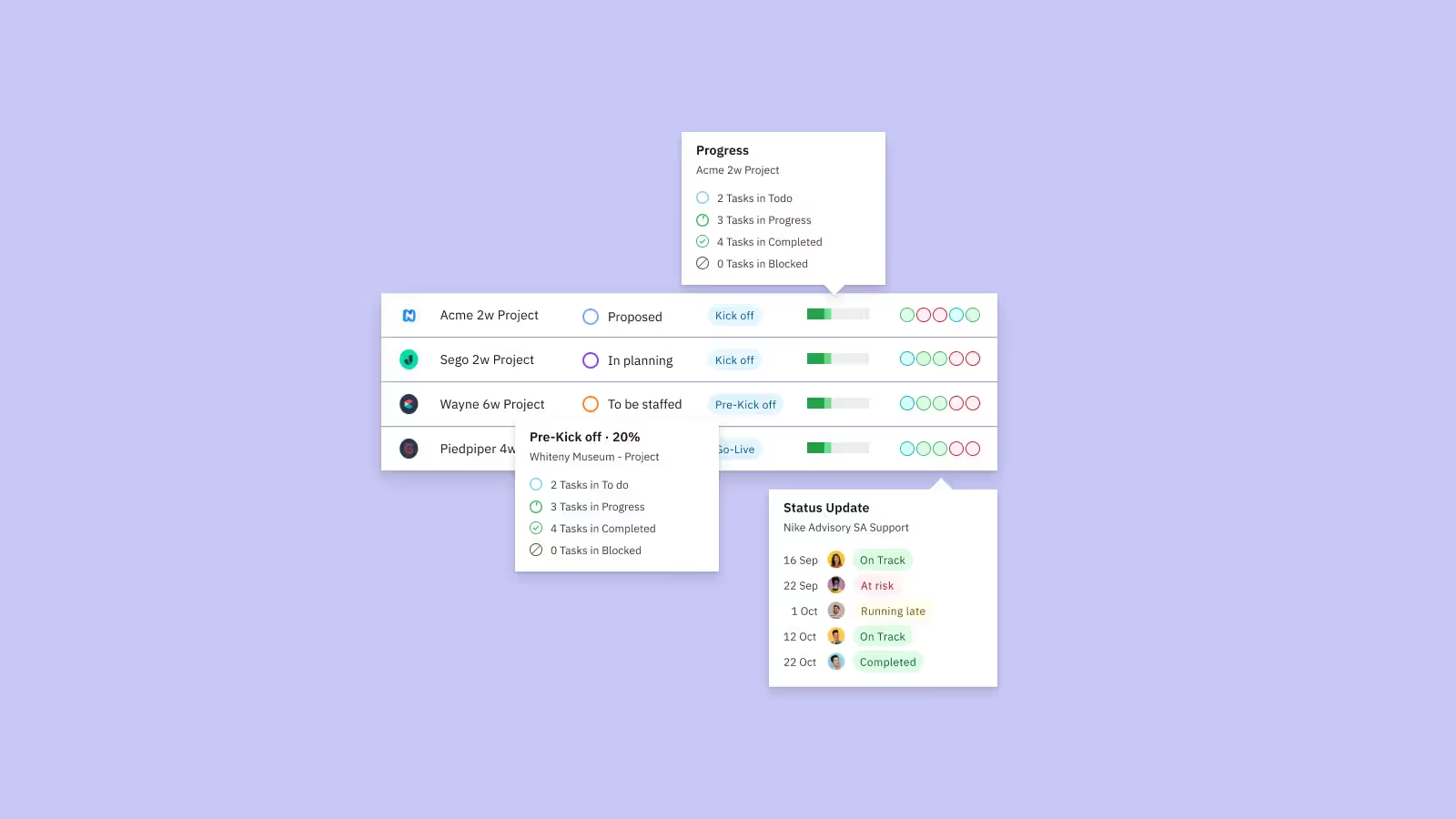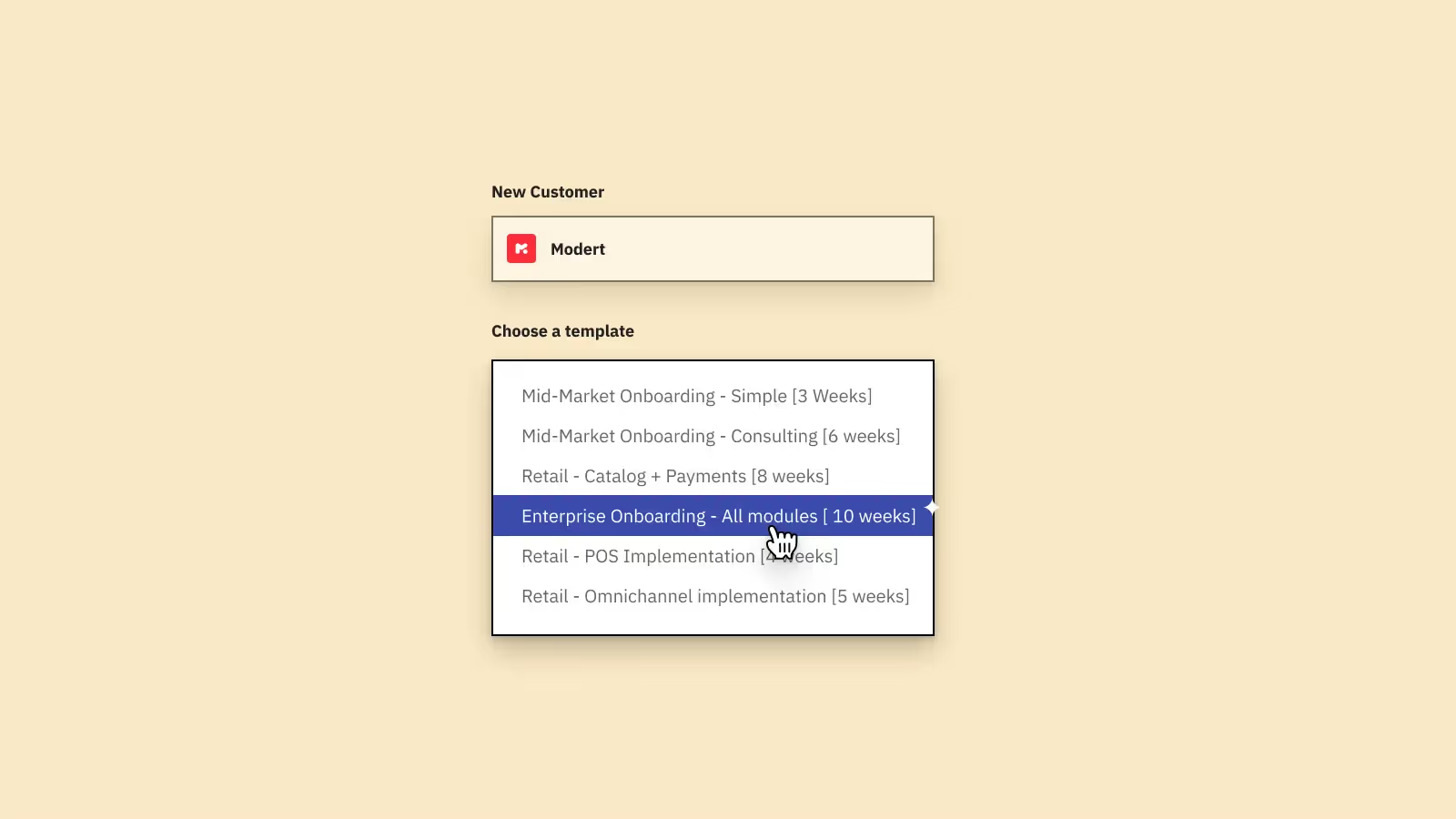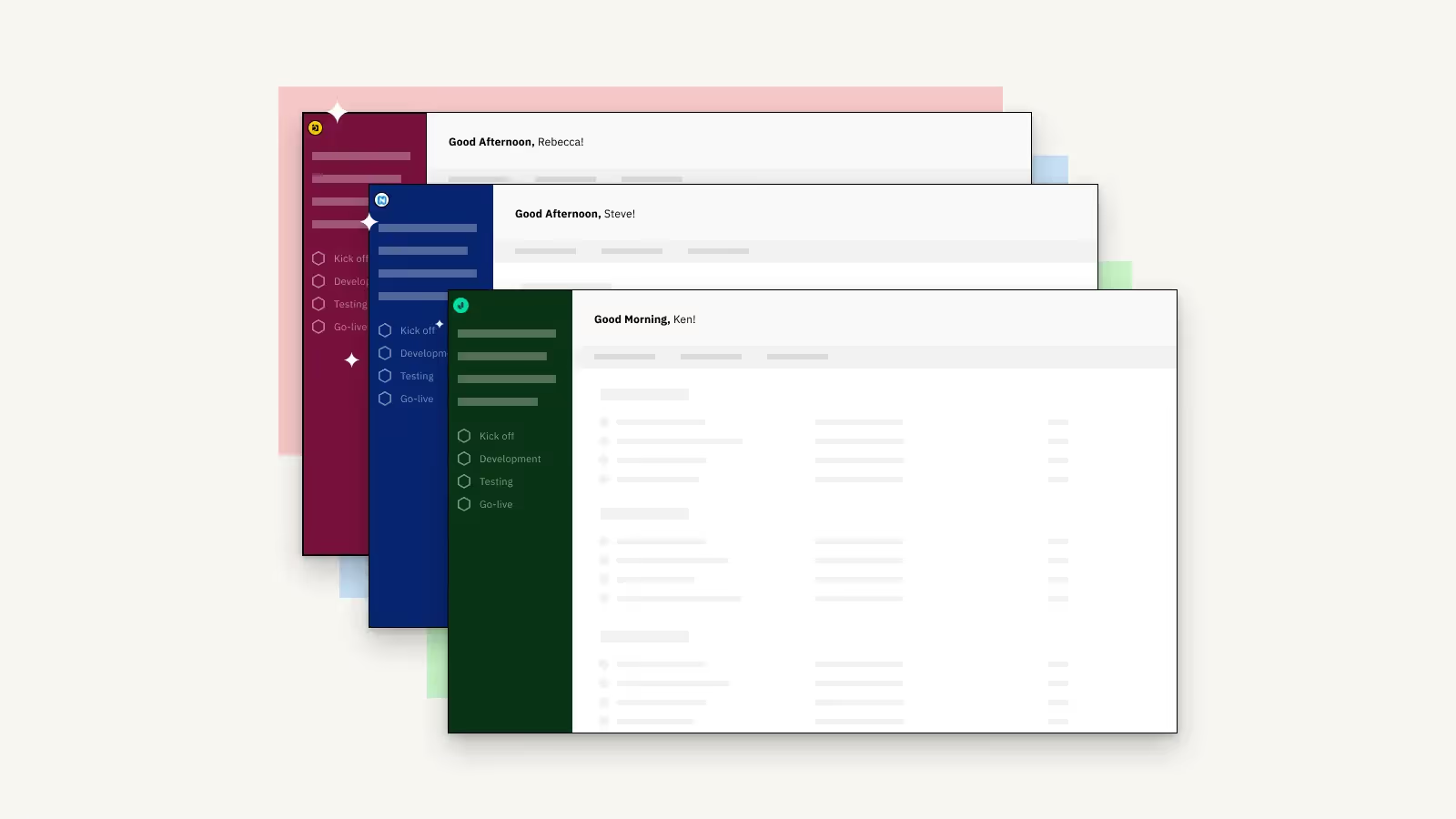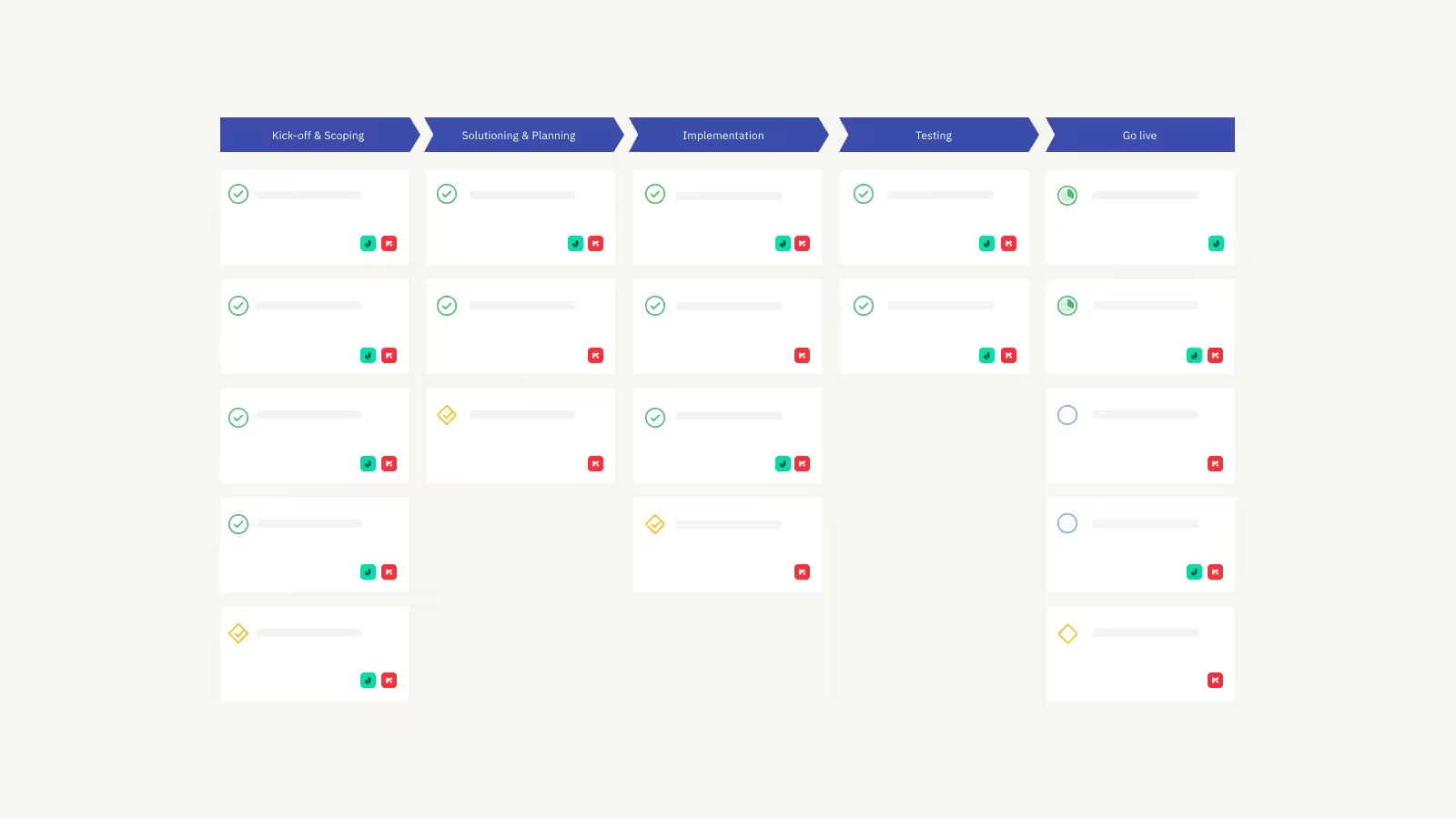A kickoff meeting is the first meeting between your project team and the client.
It marks the end of the planning stage and signifies the official start of your project.
This meeting is vital for a shared understanding of project goals.
As a result, getting this right is vital to your long-term project success.
In this article, we’ll show you everything you need to launch a good kickoff meeting. We’ll also explain what a kickoff meeting is and why it’s important.
Then, we’ll touch on what follows a kickoff, including a fantastic onboarding tool to help you with the rest of the process.
{{demo}}
What is a kickoff meeting?
A kickoff meeting is the first meeting between internal or external stakeholders and the project team.
Typically, a project kickoff meeting is led by the project manager. It’s when the project formally begins, and is scheduled after the project plans are made. .
The main purpose of a kickoff meeting is to create a shared understanding of the project and lay the foundation for a successful project.
Done right, kickoffs help the team get on the same page about the project’s goal, scope, project timelines, and milestones to avoid a project nightmare.
Let’s look at why that is.
Why a successful kickoff meeting is important
A kickoff meeting isn’t just a rudimentary check-in.
It’s a vital first point of contact with clients because:
- It helps you set expectations and clarify the project goal: You can explain how everyone will communicate and establish your project goal, timeline, and your team’s action items.
- It sets the tone for future meetings: A successful project kickoff meeting means you start off on the right foot with clients, guaranteeing a healthy working relationship for the project’s duration.
- It fosters strong morale: Kickoffs also get the entire project team to communicate openly, speak up about potential challenges, and build excitement.
Now, you may be wondering:
How do you execute a good kickoff meeting?
The 10 steps to nailing a project kickoff meeting
The best way to approach a project kickoff meeting is to have a checklist of steps you can implement with every new project.
We’ve compiled all the stages you should follow:
1) Schedule a pre-kickoff meeting
Before you meet with the client, host an internal kickoff meeting with your team.
Here, if a team member has concerns, you can note them, address issues head-on, and adjust your kickoff meeting agenda accordingly.
An internal project kickoff can help your team members feel sufficiently prepared for the main event. This way, you can put your best foot forward and present a united front to your clients.
This is an internal project kickoff discussion, so it doesn’t have to be as polished as the client project kickoff meeting.
Note: Check out our customizable pre project kickoff meeting template so you can build a solid project kickoff meeting agenda for a faultless project meeting!
2) Set up your project team
When deciding who will attend, include a team member with enough technical know-how for the project.
For example, a product manager will likely be an internal subject matter expert in their field.
Your team members will vary depending on the scope of the project as well as the size and maturity of your agency.
That said, we generally recommend team members from:
- Onboarding
- Customer Success
- Project Management
- Implementation
Also, you need a note taker for thorough and clear meeting notes to refer back to.
3) Ensure smooth handoffs
Sales and sales engineering both play a role in providing relevant client information to onboarding project team members.
Handoffs from sales should cover:
- Objectives
- Value/ROI metrics
- Functional requirements
Meanwhile, handoffs from sales engineering should cover:
- Known limitations
- Past challenges
- New functionalities or features
4) Get an overview of the project scope
Your project scope is a detailed roadmap of the work needed to achieve project deliverables.
Deliverables include the items you will send to external stakeholders that you can note on the project timeline.
However, unauthorized and unexpected changes to the project scope (also called scope creep) can massively disrupt workflow.
Firmly establishing a project scope overview as soon as possible can safeguard against such unplanned increases in project deliverables.
Instead of facing potential challenges down the line, team members can preemptively bring up concerns about your project’s timeline, scope, and budget.
5) Research your customer
Don’t rely entirely on handoffs for information. You should also conduct background research to better understand a client’s past issues and project stakeholder expectations.
This can give you a good insight into their current pain points.
However, it can be difficult to communicate your findings. To make this easier, you can use an internal database or visual aid (like an infographic) to keep track of vital background information.
6) Identify every key stakeholder
A key stakeholder is a representative from a department that will significantly impact project success.
Typically, these will be the project manager, the project team, the project sponsor, and your clients.
After research and internal discussions, create a stakeholder register to map all the project’s key members. Note their roles, contact information, level of influence, and needs.
The project sponsor can also help you identify a project stakeholder at higher levels of the client’s/customer’s organization.
You can then classify them in two ways:
- Internal key stakeholders: A stakeholder within your organization.
- External key stakeholders: A stakeholder on the client’s side.
7) Establish the kickoff meeting agenda
The agenda is the general structure of your meeting. It should give all stakeholders a clear idea of the project purpose and finer details, like who signs off on project deliverables.
Ideally, your project kickoff shouldn’t last longer than three hours, so a meeting agenda can help you track the time.
Let’s go over a rough agenda meeting template:
- Introductions: First, provide brief context about the client and their objectives. Then introduce yourself and team members, including their team roles — along with a few icebreakers (10 mins).
- Project goals, milestones, and priorities: Review the client’s expectations and discuss project milestones. Then, showcase each team’s and function’s quantitative value/ROI (30 mins).
- Blueprint walkthrough: Demonstrate a straightforward project charter (a brief version of your project plan) to the whole team. It should include your project purpose, project milestones, and scope (20 mins).
- Processes, tools, risks: Explain what project management software you’ll use, how you’ll track progress, share updates, and tackle potential challenges. Instead of overwhelming clients with multiple tools, use an all-in-one platform (20 mins).
- Key personnel and steering committee: Confirm the key stakeholders from both ends and discuss who’s signing off on project deliverables. Also, get leaders and executives to commit to a project meeting schedule (10 mins).
- Resource commitments, assets, and approvals: Ensure that you have the assets, approvals, credentials, and resources to get started. Cover how these will be shared or used in a project plan handout or Gantt chart (10 mins).
- Next steps and Q&A: Leave plenty of time for some final questions and discussion so you can clear up any concerns or confusion. Then, go over the next stages–more on that later (15 mins).
Note: Kickoff meetings can feel like information overload for clients and internal team members. A project timeline view and presentation mode can keep the agenda streamlined and efficient.
8) Send invites
When you send out invites to the project stakeholders, ensure the email includes:
- The meeting agenda
- Who needs to attend
- When they need to attend
- The roles everyone will play in the meeting
Highlight team roles like the project manager or executive project sponsor. Also, point out that you need to set up the steering committee.
The goal is to ensure external stakeholders understand these team members are a crucial part of the project kickoff.
Additionally, verify whether it’s an in-person or virtual team meeting — if you haven’t already. For remote teams, check that all key stakeholders can access online communication software like Skype, Teams, or Zoom.
9) Clarify value metrics
Collaborate with clients to identify the value metrics you’ll measure at each stage. For example:
- Number of leads
- Sales efficiency
- Automation of work
- Employee satisfaction
- Customer NPS
- ROI
At the client’s end, they must present these metrics at the kickoff so everyone involved understands the project’s value.
10) Make time for questions
By the final stage of the meeting, everyone should be eager to get started.
But don’t jump the gun!
You should dedicate plenty of time towards the end of the meeting for questions. Your project team might have queries about an action item, expectations, or the project’s scope.
Even if it seems like everything is pretty straightforward, leave no stone unturned. There’s no guarantee that everyone in the kickoff will be in the same call or room again.
As such, it’s paramount to double-check that everyone has a shared understanding of the project purpose to prevent unexpected issues.
Tip: Some internal team members may feel uncomfortable asking questions in front of the virtual team. Following the kickoff, remind employees that they can share concerns privately.
The main question is:
What comes next?
What to do after your kickoff meeting?
After the project kickoff, you should:
- Go over your meeting notes and action item list
- Reiterate where you’re documenting the work
- Briefly recap the next steps of your project plan
Then you can officially start your new project and deliver regular status reports!
There’s just one problem:
Many companies don’t do this efficiently, leaving clients in the dark about the project status.
Often, project managers make the mistake of conducting excessive follow-up meetings. While some are necessary, too many can grind workflows to a halt.
A whopping 71% of senior project managers consider most meetings unproductive.
The entire purpose of a kickoff meeting is to set the project in motion.
You shouldn’t have to constantly contact high-level project stakeholders unless it’s urgent.
Another barrier to post-kickoff productivity is losing track of important docs. This occurs when project stakeholders are forced to hop between multiple platforms to receive information.
For a successful project, you must communicate progress simply and concisely.
So, is there a way to weave documentation, communication, and collaboration together in your project kickoff and beyond?
Luckily, there’s an excellent all-in-one onboarding and project management solution.
Stay on top from start to finish with Rocketlane
You may be using multiple platforms to manage communication, document collaboration, and resources.
Naturally, this can lead to confusion for the onboarding teams and customers. This, in turn, can negatively impact their drive to engage with your product or services.
Fortunately, there’s a simple solution.
Prevent critical information from slipping through the cracks with Rockletlane!
Rocketlane’s onboarding software offers an innovative workspace that unifies collaboration, communication, and visibility. You can also share important updates and documents in one convenient location to truly perfect kickoff meetings.
Rocketlane’s dedicated platform allows you to organize information, share project status updates, and improve workflows with ease.
Let’s take a deeper look at four innovative functions the tool provides:
1) Visibility

Setting up project status updates on Rocketlane is a cakewalk.
You can share updates within the platform without the need for extra emails or meetings. Simply drag and drop elements (e.g., completed tasks, pending tasks, additional notes) to the appropriate update.
Say goodbye to platform-hopping. Rocketlane is all your customers need to keep up with a project’s progress!
2) Consistency

From the kickoff to the final phase, Rocketlane guarantees a consistent experience. You can set up a collaborative space for every type of project and customer in a few clicks.
Create and customize templates according to the customer’s industry, size, or maturity level.
Each template ties together collaborative documents, plans, and tasks for keen insight at every stage. You can even reuse them for new projects!
3) Customer experience

The tool comes with a customer portal to personalize the experience. You can tailor the portal by adding your own themes or logos. This way, customers can see the distinct connection to your brand at every step.
You can also create interactive walkthroughs to guide customers through:
- Plans
- Tasks
- Approvals
- Feedback
- Project status
4) Collaboration and productivity

Make teamwork smoother with Rocketlane’s project timeline and presentation mode!
This is perhaps the most vital feature for kickoff meetings.
Presentation mode allows you to showcase your methodology on the platform. It lays out all the phases so you can confirm exactly what resources you need and when with the customer.
Even better, you can create a project timeline to show external stakeholders what each phase will entail.
This feature removes the need for inconvenient and time-wasting follow-up meetings. Instead, you can find all relevant docs in one place and have conversations on any task or document in real-time.
Note: Rocketlane’s Slack integration makes communication even quicker!
Set the stage for a successful project journey
A successful kickoff meeting is essential to building a longstanding customer relationship.
But things can get lost in translation at this early stage, which will likely have a knock-on effect on the entire experience.
Fortunately, Rocketlane’s collaborative features provide smooth communication with all project stakeholders — and the benefits don’t end there. This singular platform makes the entire onboarding journey an absolute breeze.
If you want project success to continue beyond the kickoff, sign up for a free trial of Rocketlane today for a streamlined onboarding experience!






















.webp)
